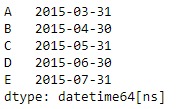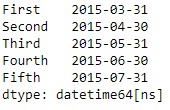Python是进行数据分析的一种出色语言,主要是因为以数据为中心的python软件包具有奇妙的生态系统。 Pandas是其中的一种,使导入和分析数据更加容易。
Pandas DatetimeIndex.to_series()函数使用索引和等于索引键的值创建一个Series,该索引对map有用,用于基于索引返回索引器。
用法: DatetimeIndex.to_series(keep_tz=False, index=None, name=None)
参数:
keep_tz:返回保留时区的数据
index:所得系列的索引。如果为None,则默认为原始索引
name:所得系列的名称。如果为None,则默认为原始索引的名称
返回:系列
范例1:采用DatetimeIndex.to_series()函数根据给定的DatetimeIndex对象创建系列对象。还设置该系列的索引值。
# importing pandas as pd
import pandas as pd
# Create the DatetimeIndex
# Here 'S' represents secondly frequency
didx = pd.DatetimeIndex(start ='2018-11-15 09:45:10', freq ='S', periods = 5)
# Print the DatetimeIndex
print(didx)输出:

现在,我们要根据DatetimeIndex对象构造一个序列。
# construct the series
didx.to_series(index =['A', 'B', 'C', 'D', 'E'])输出:

从输出中可以看到,该函数返回了一个由didx DatetimeIndex对象构造的系列对象。范例2:使用DatetimeIndex.to_series()函数根据给定的DatetimeIndex对象创建系列对象。还设置该系列的索引值。
# importing pandas as pd
import pandas as pd
# Create the DatetimeIndex
# Here 'M' represents monthly frequency
didx = pd.DatetimeIndex(start ='2015-03-02', freq ='M', periods = 5)
# Print the DatetimeIndex
print(didx)输出:

现在,我们要根据DatetimeIndex对象构造一个序列。
# construct the series
didx.to_series(index =['First', 'Second', 'Third', 'Fourth', 'Fifth'])输出:

从输出中可以看到,该函数返回了一个由didx DatetimeIndex对象构造的系列对象。
相关用法
- Python pandas.map()用法及代码示例
- Python Pandas Timestamp.now用法及代码示例
- Python Pandas Timestamp.second用法及代码示例
- Python Pandas DataFrame.abs()用法及代码示例
- Python Pandas Series.lt()用法及代码示例
- Python Pandas dataframe.all()用法及代码示例
- Python Pandas DataFrame.ix[ ]用法及代码示例
- Python Pandas Series.pop()用法及代码示例
- Python Pandas TimedeltaIndex.max用法及代码示例
- Python Pandas Timestamp.dst用法及代码示例
- Python Pandas Timestamp.tz用法及代码示例
- Python Pandas Series.mean()用法及代码示例
- Python Pandas TimedeltaIndex.min用法及代码示例
- Python Pandas Series.ptp()用法及代码示例
- Python Pandas dataframe.cov()用法及代码示例
注:本文由纯净天空筛选整理自Shubham__Ranjan大神的英文原创作品 Python | Pandas DatetimeIndex.to_series()。非经特殊声明,原始代码版权归原作者所有,本译文未经允许或授权,请勿转载或复制。
